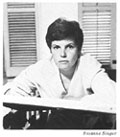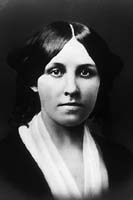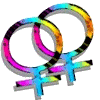 |
||
|
||
|
Part 1 of 5 |
||
|
|
||
When I went to college in 1978, I had never read a single work of fiction about a lesbian character. Not one. Though I spent hours on end in the library, and I read voraciously, the countless books I read and the TV shows and movies I saw presented heterosexuality as the only reality. No other options were presented. I recall nothing positive about lesbians being shown during my teen years in any of the media to which I had access. Steven Capsuto, in his book Alternate Channels: The Uncensored Story of Gay and Lesbian Images on Radio and Television, notes that in 1974, six prime-time dramas in the United States portrayed lesbian, gay, bisexual, or transgender characters, and "all were rapists, child molesters, or murderers." Until the late 1980s and early 1990s, unfortunately, this continued to be the case. Considering the negativity and disrespect historically accorded to homosexuals, it's a wonder that we haven't just curled up and died. How do people go on without role models, without a vision or ideal by which to live? I suppose other "non-straight" women like me were occasionally presented with that rare lesbian image or feminist concept, and like a cactus in the desert, we clung to those images and concepts as though we'd die of thirst without them. What a vast desert existed before the last three decades of the 20th century!
|
||
| A
Dry, Barren Literary Land |
||
| I loved the work of Louise Fitzhugh (1928-1974), particularly her Harriet the Spy. How strange it was to learn so many years later that Fitzhugh lived her entire life as a closeted lesbian. Still, some of that sensibility shone through in her work. I recognized a part of myself in her characters, especially in terms of their search for--and demanding of--autonomy and individuality. |
 Louise Fitzhugh |
|
| I
also read all of the novels of Louisa
May Alcott (1832-1888). She never confirmed her sexual orientation,
though she is reported to have said, during an interview: "I
have fallen in love in my life with so many pretty girls and never
once the least bit with any man." Again, a lesbian sensibility
gleamed from her work, and I felt a serious affinity with Jo of her
Little Women. |
 Louisa May Alcott |
|
|
Moving from
the Desert Until the late
1970s, lesbian-identified women did not write and publish works of
fiction showing out and proud lesbians. No books showed overt images
of anything strong or positive about characters who were not interested
in what Adrienne Rich called "compulsory heterosexuality."
|
||
| In the absence of images and role models, lesbian readers have had to get by for a very long time without literary sustenance, and it can't possibly have been easy. But little by little, some of the stories of brave women who "lived as they pleased" (as Natalie Clifford Barney once said) have come to the surface. Women have been steadfast and resilient. Perhaps they weren't published and their lives were not celebrated, but they have been there! This new Lesbian Fiction Herstory Page will explore some of those women. The trickle of works that came out in the early 20th century has now become a stream. Oceans of knowledge and information are opening to lesbian writers and their readers. Let's explore the herstory of how we got where we are. At times I may focus on a theme or movement; other times upon a particular woman or her writings. Please join me in this exploration. If you are thirsty
to learn about a particular topic or have information to share, please
write to me at: Until next time! Lori |
||
 | ||
| This page last updated on July 2, 2022 Go to other parts of the Lesbian Herstory Series: Part
1 Or Return to Lori L. Lake's Main Website All contents of this web site are protected by U.S.
and International copyright laws | ||
 Lesbian
Fiction Herstory
Lesbian
Fiction Herstory